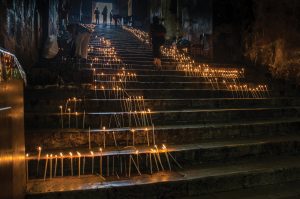Introduction
The high volume of Christian emigration from Palestine has grave repercussions on the Christian presence in the Holy Land. Several leaders have recognized the gravity of the situation and have warned of the danger of the Holy Land being transformed into a kind of Christian theme park, stripped of its authentic Christian inhabitants. In truth, there is no exaggeration in that warning. After all, the dwindling Christian population of historical Palestine makes up, at best, no more than 1.7 percent of the total population today, including the Christian population in Israel as well as in the West Bank and Gaza Strip.
With the aim to understand how this phenomenon of Christian migration from Palestine developed, I resolved to study the various circumstances that led to the current decline through an entire century based mainly on the official censuses conducting by the Ottomans in 1905, by the British in 1922 and 1931, by the Jordanians in 1961, by the Israeli military occupation in 1967, by the Palestinians in 2007 and 2017, and by the Israelis in several years between 1949 and 2011.
Christian migration in the Ottoman period
Up until the year 1917, Palestine was an inseparable part of the expansive Ottoman Empire, and residents, whether Muslim or Christian, were free to move in and out of the empire. Between the years 1860 and 1914, Ottoman estimates indicate that Christians constituted around 11 percent of the population in Palestine.
During the last three decades of the Ottoman Empire, Christian migration from Palestine became a significant component of the larger regional migration as up to one million migrants from the region left for North and South America. Some historians supposed that the reasons for leaving included financial ambition and the desire to escape the poverty and illness that infected the region at the time. Other accounts demonstrated that while Christians during the Ottoman period were exempt from serving in the army in return for paying the jizya tax, the Young Turks, who assumed power in 1908, sought to integrate Christians into the army.
What distinguishes the migration of Christians from Palestine is that the notion of the “Holy Land” was coming to prominence during this era. This led to a sharp increase in the sale of “Holy Land” crafts by Palestinian immigrants to religious pilgrims at home and abroad. Emigration thus increased so much, in fact, that during the ten years prior to World War I, Bethlehem lost half its population, dropping from 12,000 inhabitants to a population of 6,000. There has been speculation that 13 percent of the Christians from Palestine migrated between 1907 and 1917.
Even though the main motive for emigration – to escape the compulsory conscription in the army – was no longer effective after the end of World War I and the start of the British Mandate in Palestine, policies restricted Palestinians who had emigrated from returning to their home country. At the end of World War I, the number of Christian Palestinians was recorded as 8 percent of the total population.
The Palestinian displacement of 1948 (Nakba)
Whereas the first wave of immigration may have been somewhat by choice, the second wave of Palestinian displacement from the land was coercive. As a result of the 1948 catastrophe and its d estruction of more than 420 villages, more than 700,000 Palestinians were forcibly evicted from their homes, soon to become refugees in what remained of Palestine and the surrounding region. Today, the number of Palestinian refugees has reached more than 6 million; the largest number of refugees in the world.
The 1948 Nakba had an immense and specific impact on Palestinian Christians. In a matter of months, almost 50,000 Christians out of 135,000 were displaced. Their numbers, which had constituted 8 percent of the population (in the previous year) dwindled to a shocking 2.8 percent after the Nakba. This left a most devastating blow on Christians in Palestine from which they have not recovered. Much like the situation under the British Mandate, Israeli authorities prohibited the return of Palestinians to their homes. The study conducted by the Evangelical Lutheran Christmas Church in Bethlehem may give us deeper insight into the profundity of the tragedy for Christian Palestinians. In a census conducted by Rev. Elias Shihadeh Khoury in 1950, we find that the number of Lutherans in Bethlehem during that year reached 528 members, two thirds of whom were expelled in 1948. The remaining third did not stay in Bethlehem either; more than 50 percent withdrew to Jordan after the Naksa in 1967.
The Christian Palestinians of the diaspora maintained strong bonds and religious ties with their families in the West Bank, yet the study of the Christmas Church demonstrates that after the occupation of 1967 (Naksa), Christians from Palestine ultimately lost not only their right of return but also the right to visit their families in the West Bank.
Migration during the Jordanian period
The period of Jordanian rule in Palestine between the years 1949 and 1967 witnessed an escalation of internal migration from the West Bank to the East Bank. The new emerging Kingdom of Jordan was eager to build its capital Amman; and for that reason, it needed educated persons and skilled labor, which were found in the larger Jerusalem area between Ramallah and Bethlehem. On the other hand, the Gulf region and other oil-producing countries were growing fast and also needed educated people and skilled labor, and they turned to Palestine to find them. Studies indicate that between 1952 and 1961, almost 15–22 percent of West Bank inhabitants left their homes, and between 1961 and 1967, this number was reduced to nearly 11–16 percent.
More specifically, the number of Christians in the West Bank declined from 42,618 in 1961 to 29,446 – which means that one-third of Palestinian Christians left the West Bank, and their percentage dropped from 5.8 percent to 4.9 percent.
The impact of the Israeli occupation on Palestinian Christian migration
The pressures of the Israeli occupation obviously amplified obstacles and led to a fourth wave of Christian emigration. The enforcement of people and the ongoing constraints, discriminatory policies, arbitrary arrests, and confiscation of land added to the general sense of hopelessness amidst wars and destruction throughout the region. In this era, most Christian Palestinians set their sights on Europe, the United States, and Canada as potential places to find refuge.
In this section, I will discuss three studies that we conducted during the last twelve years. The first is a study we prepared in 2008 on Christian Palestinians in the West Bank. The second is a study on Christian Arabs inside the Green Line (Israel) that we prepared in 2012. And the third is a more recent study that includes an opinion poll implemented in 2017.
In 2017, the Palestinian Central Bureau of Statistics census demonstrated that the total population of Christian Palestinians in the West Bank and the Gaza Strip combined was around 47,000. In our first study, conducted in the year 2008, the causes of Christian emigration were indicated as follows:
– Almost a third (32.6 percent) opted to emigrate due to the loss of freedom and absence of safety amidst the occupation, making the Israeli occupation the first and foremost reason for departure.
– Almost a fourth (26.4 percent) left because of the deteriorating economic conditions.
– Around a fifth (19.7 percent) succumbed to the option of emigration due to political unrest, especially during and after the second Intifada.
– More than a tenth (12.6 percent) took off for the pursuit of education. This is not a small percentage of youth intellect and should not to be underestimated.
– Only less than half of one percent (0.3 percent) were motivated to leave for religious purposes. This percentage is so small that it dismisses as irrelevant the premise of religion as a cause for emigration.
The 2012 study demonstrated that the causes of the emigration of Christian Palestinians within the Green Line were numerous. Israeli military laws that were in practice between the years 1948 and 1966 had preemptive measures that isolated Palestinians, restricted their freedom of movement, and prevented their access to the labor market. In addition, discriminatory Israeli policies obstructed Palestinians from pursuing certain academic degrees in such fields as medicine, science, technology, research, and security-related fields, prompting many Palestinians in Israel to pursue their education abroad. Israeli employment policies that discriminated against Arab Palestinians saddled them with economic challenges, and the unceasing Israeli-Arab conflict and absence of any feasible solution put Palestinians in a continuously strenuous situation.
The most recent study on the emigration of Christians was conducted in 2017 and included a sample of 530 Palestinian Christians and 500 Palestinian Muslims. This study is the first of its kind to include Palestinian Christians and Muslims alike.
It is disturbing to acknowledge the high percentage of Christian respondents who are considering emigration: 28 percent in general, and 47 percent in Gaza, which is especially high in relation to the West Bank which is 25 percent. The estimates among Muslims are slightly lower: 24 percent in general, 27 percent in Gaza, and 23 percent in the West Bank.
The two main reasons for considering emigration are political instability and the economic situation, which is the dominating factor at 64 percent among Christians and 72 percent among Muslims. In contrast, the number one reason for staying in the country and not considering moving abroad is the Palestinian sense of determination to resist: 41 percent of Christian respondents and 49 percent of Muslim respondents expressed that perseverance is their reason to stay.

Conclusion
The steady decline of Christians in the Middle East and specifically in Palestine is a troublesome matter, and it has hazardous repercussions not only on the Palestinian Christian community but on the entire society as well. Without the presence of the Christian Palestinian people, the Holy Land – the land of origin of the Christian faith – would become little more than a mere site that contains old ruins and empty churches and buildings.
The Christian departure from Palestine deprives the country of a spectacular 1,400-year interfaith heritage. To squander such an exceptional foundation would be to lose a glorious and expansive cultural heritage. If Christians disappear from Palestine, Palestinian society would lose a very important ingredient of its religious and cultural tapestry that has safeguarded the pluralistic nature of Palestine, making it a bridge between the Arab-Islamic and Western worlds.
This article is based on Palestinian Christians: Emigration, Displacement, and Diaspora, by Mitri Raheb, Diyar Publisher, 2017.



